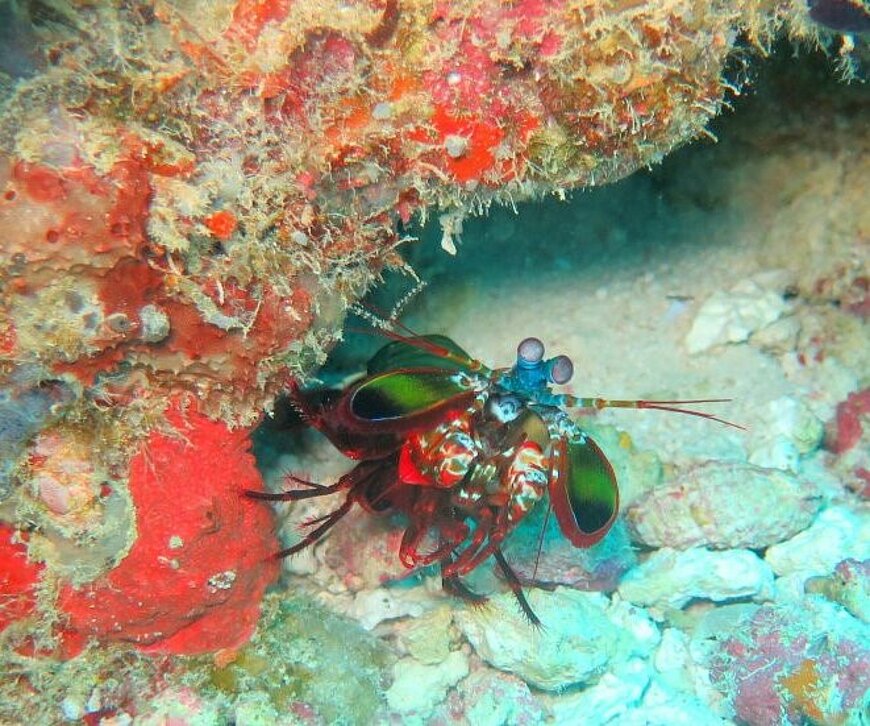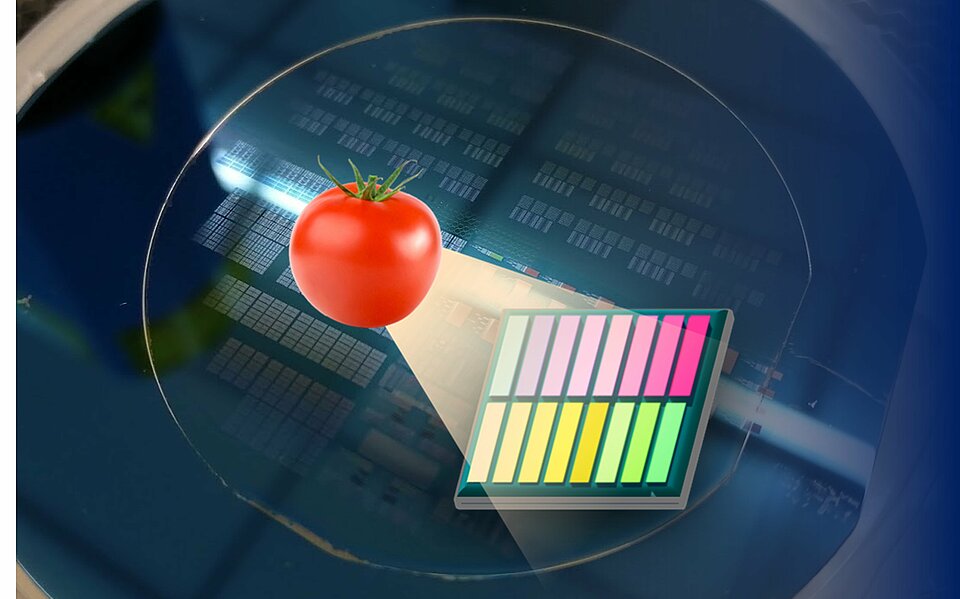Photonics startup Mantispectra takes chemical analysis out of the lab

Who says chemical analysis needs to be performed in a laboratory, by well-trained personnel? Thanks to a photonic-chip-based spectral sensing system being commercialized by startup Mantispectra, classifying and quantifying material composition will never be easier.
There’s only so much a farmer can tell about his crops just by looking at them. A tomato that has turned red, for example, is certainly getting closer to harvest. But when is it optimal to harvest? Dry mass, sugar content or the concentration of other tasty compounds may still be increasing, all of which will be wasted if the fruit is plucked too early.
By providing farmers with an extra set of eyes, startup Mantispectra aims to solve this problem. The spinoff from Eindhoven University of Technology (TUE) is developing a portable optical sensing system that, in mere seconds, yields a wealth of information about the chemical composition of a tomato. This information wouldn’t only be useful for determining optimal harvest timing but also for optimizing growth conditions and, after harvest, quality control in the distribution chain.
Of course, tomato farmers aren’t the only ones that can benefit from such a device. Not only does the technology extend to many other crops, but there are many applications outside of agriculture and food as well, such as in textile recycling, pharmaceutics and healthcare. Even consumer electronics is within the realm of possibilities: imagine people using their smartphone, equipped with Mantispectra’s sensor, to determine if their milk has gone sour or if has been adulterated.
“Taking spectrometers – which normally are bulky and expensive scientific instruments that require trained operators – out of the lab to perform real-time chemical analysis wherever needed opens up a great number of applications in many different markets. I’m sure we haven’t encountered, or even thought of, them all,” says CEO Maurangelo Petruzzella of Mantispectra. “Leveraging the expertise of the public-private photonics partnership Photondelta and the infrastructure that the Dutch integrated-photonics industry has already built up, I’m confident we can swiftly scale up our technology to take advantage of these opportunities.”
A little crazy
The young company’s name refers to the Mantis shrimp, a marine crustacean with one of the most complex eyes in the animal kingdom. Humans have three types of photoreceptor cells, which are sensitive to red, green and blue light. The Mantis shrimp’s eye contains up to sixteen photoreceptors, which can detect light ranging from the deep ultraviolet to the far red. The core technology of Mantispectra is a tiny chip that also has sixteen ‘photoreceptors’ on board, each detecting a different band of light. Unlike the sea animal, however, the chip only detects bands in the near infrared (near IR), which spans the 820-1680 nanometer range, from which a wealth of chemical information can be obtained.
“Our chip, roughly measuring 1 by 1 millimeter, consists of an array of sixteen indium gallium arsenide pixels bonded on silicon. The pixels differ only in the type of filter integrated within them, which is sensitive to a particular near-IR band. The operating principle of our sensing system is to shine broadband near-IR light on the sample and collect the reflected light with our chip. This results in a kind of ‘fingerprint,’ which is our raw information,” explains Petruzzella.
For the raw information to become useful, it needs to be plugged into a machine learning-based model, which correlates the measured reflection intensities (or lack thereof) to the chemical composition of the sample. Drawing up such a model is quite a bit of work, but once done, you’ll never have to do the measurement the old-fashioned and time-consuming way again. For several interesting application cases, Mantispectra will provide a pre-made model that can be directly deployed. At the same time, the company will offer the possibility for the user to build new models to assist them in their creation and validation.
As proof of principle, Mantispectra is currently working with partners in the agro-food industry to build such a model. Going forward, the startup intends to provide interested parties – potential end-users, instrument vendors and system integrators – with its technology, so they can try it out for their applications. “To be honest, things are getting a little crazy right now. We’ve been receiving an incredible amount of inquiries from all over the world. With our resources, it’s challenging to comb through all of them and filter out the most promising ones,” says Petruzella.
Depending on the specific use case, Mantispectra will market its own products or give out licenses for others to include the spectral technology in their products.
Scaling up
The detector chip is the heart of Mantispectra’s product, but obviously it isn’t a standalone system. To become fully functional, it needs to be assembled into a module, which contains some basic optics, a light source and electronics to process the measurement and/or transfer the data via USB to a computer. Having successfully developed prototypes, Mantispectra recently started production of a batch of fully functional modules for distribution to prospective customers and partners. In parallel, it has started working on industrialization challenges, such as assessing the reproducibility of the chips and modules and compliance with international standards.
For the moment, Mantispectra’s chips are fabricated at TUE’s cleanroom facilities. Once the technology gains traction and volumes pick up, however, the production process might be outsourced to local partners. “It’s great to be in this region because there already is a lot of activity in the area of integrated photonics. For us, having access to a local foundry and an assembly facility is invaluable,” says Italian-born Petruzella, who originally came to the Netherlands to carry out his PhD at TUE.
The Dutch integrated-photonics ecosystem has united in the public-private partnership PhotonDelta (see inset “PhotonDelta’s growth strategy”), aiming to establish a world-leading industry. PhotonDelta fosters (international) collaboration, promotes knowledge sharing among members, charts roadmaps and supports companies, particularly startups, with business aspects. “PhotonDelta has been of great assistance, particularly with connecting this technology to early adopters. With all its knowledge and experience, I expect PhotonDelta will keep playing a key role in scaling up our business over the coming years.”


The growth strategy of PhotonDelta
PhotonDelta was founded in January 2019 to stimulate the growth of the emerging Dutch integrated photonics sector. Its mission is to ensure that by 2026, turnover (more than €1 billion), resources (more than 4,000 FTEs) and the number of companies (more than 25) will have grown using the financial resources made available by the public sector. "These objectives pose a challenge given that, in addition to the relatively limited time and resources we have, we are also facing a twofold problem: a new emerging technology with - in the long term - possibly also emerging applications and markets," says Giuseppe Coppola, Head of Strategy and Business Development Officer at PhotonDelta.
In order to cope with this complex situation and to identify the most relevant growth opportunities, PhotonDelta and its partners worked in a structured manner. First, the partnership carried out a thorough analysis of the relevant trends, growth factors and product opportunities in a large number of markets. Subsequently, the most attractive opportunities were compared with the product and technological possibilities within the sector. In this way, four important target markets were identified at the end of last year: medical equipment & life sciences, datacom & telecom, infrastructure & transport and agriculture & food. A team was then set up per target market consisting of technology experts from companies and knowledge institutes who, in open cooperation with customers and end users worldwide, further sharpened the relevant propositions and business/technological roadmaps. The insights gained have been leading for PhotonDelta's investments and for its strategy and implementation, in order to further expand its portfolio and acquire new customers and cluster partners.
The activities of Mantispectra are part of the agricultural & food market and fall under the focus area "NIR spectral detection modules and components for the analysis of nutrients, taste and structure of fruit and vegetables".

